Eventually, 150,000 men went into the English Channel in Normandy and pushed beyond to fight those German invaders. It wasn’t a beautiful view, to say the least. In fact, it was catastrophic and something most men couldn’t stop remembering. This is part of our history, and the next 40 photographs give you a real view of what happened on that day.
On the March
If you didn’t notice that sea of troops, it might be a beautiful sight. These men were from the British 50th Division of the Infantry and had reached Gold Beach. They pushed to Crepon, forcing the Germans to move south. Finally, they got to Normandy and victory.

On the March
Sleeping in the Foxhole
You can see a GI getting some sleep in his cramped foxhole. It’s difficult to say if those were his boots or another man’s who was also there. Still, there are two kits. The men are peaceful now, but those two hand grenades show that they were ready to fight.

Sleeping in the Foxhole
Arriving on Juno Beach
While the tide was out at the time, it may have been easier for these Canadian soldiers to cross the dunes on Juno Beach. This was one of the five primary landing locations on D-Day. In the back, there’s Bernieres-Sur-Mer, a coastal village, but no weapons were pulled.

Arriving on Juno Beach
Danger
Robert F. Sargent captured this still. As the chief photographer, he chose to call it “Death’s Jaws,” which is fitting. This is one of the most common photos of the D-Day landing, and it shows soldiers from the First Infantry Division of the US Army rushing behind that Omaha Beach ship.

Danger
Rommel’s Asparagus
Erwin Rommel, a German military field marshal, had been assigned to charge at Atlantic Wall. The poles you see on the beach were referred to as “Rommel’s Asparagus.” The photograph was taken in 1944, right before the attack.

Rommel’s Asparagus
Before the Storm
The GIs here seemed calm while they spoke to Mary Jane Cooke. The Red Cross volunteer noticed how quiet the troops were because they were waiting for their day excursion into Normandy. They might have been in line but weren’t relaxed.

Before the Storm
Getting a Ride
The British troops had bicycles in the water since they couldn’t land on the banks of Normandy. This was a popular practice in the area. Overall, the photograph showed a simulated war, though the men fought for real in just a few weeks.

Getting a Ride
Axis Prisoners
You can see a large group of prisoners that were taken by the Axis in this photo from 1944. The Allies had struggled to reach the French land from the beaches, so more Axis forces had to surrender. About 4,000 soldiers were taken just on D-Day.

Axis Prisoners
Assault at Omaha Beach
The 16th Infantry Regiment troops landed at Omaha Beach and experienced heavy German opposition. These soldiers used the cliffs as cover. Overall, 2,400 men were injured, went missing, or got murdered here on D-Day.

Assault at Omaha Beach
Downtime
The Allies had to battle their way into France from the beaches of Normandy, though they delayed a moment. Roughly 40 miles from the shore, the men in Argentan were found. Finally, the 80th Infantry Division took that town in August of 1944.

Downtime
D-Day+1 on Omaha Beach
The 2nd Infantry Division of the US Army passed a German bunker while leaving Omaha Beach. Their battle was over because it was one day after D-Day. Still, the shoreline was defended heavily, so people were careful.
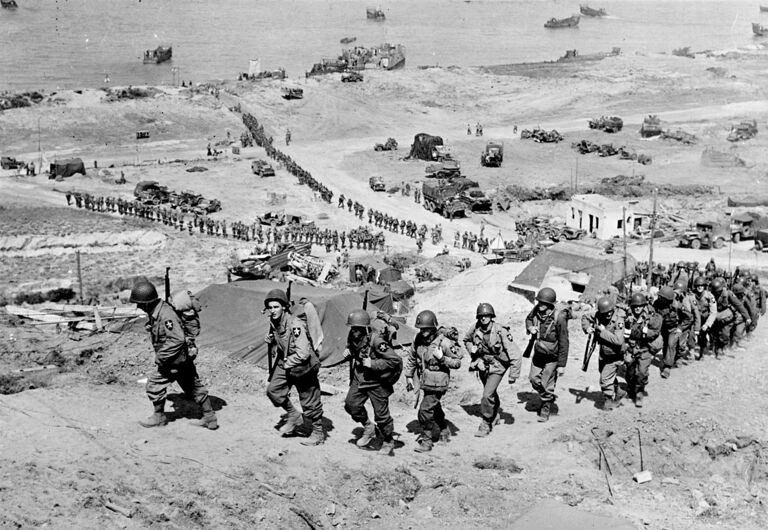
D-Day+1 on Omaha Beach
B-26 Marauder
The bomber crew from the B-26 Marauder smiled in this picture taken in July of 1944 because they’d had a successful mission. In fact, aircraft were crucial for the Normandy invasion. Roughly 11,000 Allied planes went on about 200,000 flights between April and June.

B-26 Marauder
Going to Sword Beach
The British ISB commandos in this picture were going to Sword Beach in France. Once they got to the shore, they were after Germany. However, German defenders put up a brutal fight and overwhelmed the group.

Going to Sword Beach
Tidying Up the Beach
Roughly 225 soldiers got assaulted at Omaha Beach. Colonel James E. Rudder commanded the Ranger 2nd Battalion and was to cripple the enemy’s weapons. However, it took two days to do, though they were triumphant in the end.

Tidying Up the Beach
Sherman Tanks
The US Army (741st Tank Battalion) had these M4 Sherman tanks. They used a transportation boat to assist during the Normandy invasion. Can you see the odd things behind those vehicles? They’re snorkels that prevent the motors from stalemating or flooding.

Sherman Tanks
Bill Millin and the Bagpipes
Bill Millin couldn’t go anywhere without wearing/playing his bagpipes. The Germans thought the 1st Special Service Brigade Commando was crazy, but his comrades deemed him courageous. He’s now immortalized for his antics.

Bill Millin and the Bagpipes
Surrender on the Seaside
The Axis party below had two commanders and was taken by a Canadian soldier holding a fixed bayonet. These prisoners were actually taken on D-Day from Juno Beach. Overall, the troops had opposition and were still successful!

Surrender on the Seaside
US Rangers for Battle
You can see these four men on a landing ship on its way to Omaha Beach. They were in Weymouth at the time, and it was safe. However, some of the 5th Ranger Battalion were happy about their impending attack because they wanted to fight and get it over with.
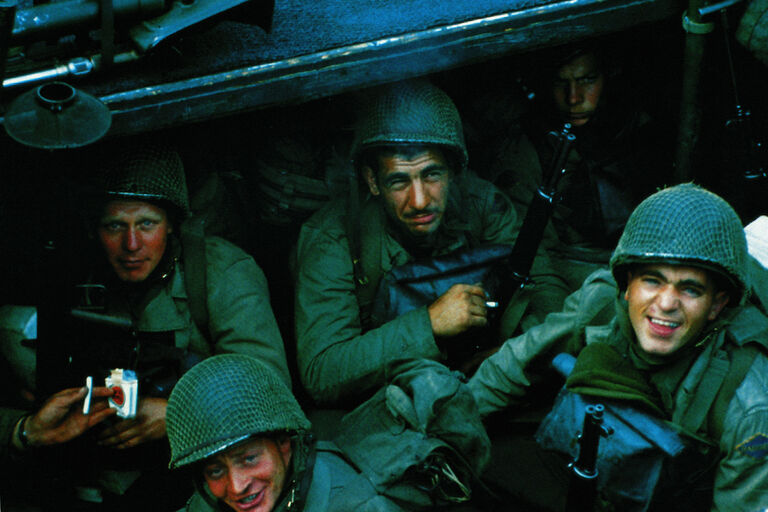
US Rangers for Battle
The Gold Beach Shore
Northumbrian British commandos from the 50th Infantry Division never wasted time when they landed. Gold Beach was a crucial attack site and one of five. Soldiers set up a solid base against the German defenders.

The Gold Beach Shore
D-Day Paratroopers
The stress those men felt can be experienced through this photograph. You see paratroopers on their way to Normandy in a Douglas C-47 for D-Day. These brave men threw themselves from an airplane into unknown territory.

D-Day Paratroopers
Huge Operation
The Normandy assault was quite large. Below, you see ships and landing boats in the water. However, balloons are in the sky, with people, goods, and cars on the shore. This is a chaotic image that shows the craziness of D-Day on Omaha Beach.

Huge Operation
Cherbourg Welcomes the Americans
The Allies were supposed to battle Axis soldiers, but they were concerned about the supplies. Germans were fanatically defending the main Cherbourg port, though it still had to be taken. Eight days of fighting finally led to success for the Americans.

Cherbourg Welcomes the Americans
Operation Tonga
These four paratrooper commanders were from the British 6th Airborne Division, preparing for Operation Tonga. They were synchronizing watches at 11 p.m. on June 5, 1944. These men were landing in hostile areas and were the first to be on foreign land.

Operation Tonga
Saint-Aubin-sur-Mer
On D-Day, you can see a Juno Beach village called Saint-Aubin-sur-Mer. The Marine soldiers of the 48th Royal disembarked quickly from their landing crafts because they were ready to experience dry land. Still, they suffered a 50 percent loss.

Saint-Aubin-sur-Mer
The Trip to France
Most people read the guidebook for the country they visit, and that’s what these soldiers did from the Scottish 51st Highland Division. They were waiting to fight, and it seemed like a fun thing to do. Overall, they were the second wave at Gold Beach.

The Trip to France
Omaha Beach Is Next
You see soldiers rushing across the sea on D-Day, pushing through to Saint-Laurent-sur-Mer. They ended up wading out and faced enemy fire. Though they suffered many losses, they overpowered the Germans on June 7.

Omaha Beach Is Next
Caen’s Kindness
Caen had a transportation center that was the Allies’ key objective since it had highways and waterways. Germans were set to protect the city, but British and Canadian forces overtook it after fighting for six weeks. This elderly woman crosses the wreckage later.

Caen’s Kindness
Disembarking on D-Day
Allied forces spent many years preparing for D-Day. Winston Churchill was the British leader, but Franklin D. Roosevelt was the US President. Both political characters played a part and knew a European invasion was crucial for success.

Disembarking on D-Day
The Saint-Lambert-sur-Dive Surrender
These German troops were finished on August 21, 1944. About 175 Canadian troops took Saint-Lambert-sur-Dive, which is 35 miles from the coast of Normandy. The hostages had to give up because there was nothing else to do.

The Saint-Lambert-sur-Dive Surrender
Eating Time
Most people say that the Army marches on its stomach, though Napoleon Bonaparte and Frederick the Great didn’t believe such things. Regardless, you see soldiers eating on a landing ship to Normandy. They needed strength to fight hard.

Eating Time
Saint-Aubin-sur-Mer Street Fights
The 3rd Canadian Infantry Division had to deal with the rubble found at Saint-Aubin-sur-Mer. That city was fortified significantly, and the North Shore Regime had been in many battles. Over 124 people lost their lives.

Saint-Aubin-sur-Mer Street Fights
Woman Smiling
One week before D-Day, this picture was snapped of a woman smiling. May 28, 1944, saw a peaceful time, and the England forces were also clean and relaxed. Clearly, Operation Overlord hadn’t happened because there was no turmoil or bloodshed.

Woman Smiling
Taking Cover on Utah Beach
Covering Utah Beach was the main goal for the 8th Infantry Regiment soldiers. Men were rushing up the pitch with wild abandon, but the area wasn’t as guarded as others. In fact, it had the lowest casualty count of all Normandy beaches.

Taking Cover on Utah Beach
Enjoying a Joke
No one knows who said it or what the joke was about, but people thought it was funny. American paratroopers fell on Sainte-Mere-Eglise on D-Day. Since they had to stop somewhere, it was good the town was happy to have them.

Enjoying a Joke
Walking Wounded
You can see American servicemen walking away with their injuries, but they were the fortunate ones. Most of their friends were injured or killed during the D-Day attacks. They were coming off the ship at Southampton Port to receive treatment.

Walking Wounded
A Little Longer
The 18th Infantry Regiment hit Omaha Beach in the easy-red area. The door was soon to fall on the sand, plunging them into all the action. Some of the worst fights were here because those rocks were difficult to penetrate.

A Little Longer
The Accordionist
The soldiers here weren’t part of the battle yet. In fact, they were going to England on June 22 and were still waiting for the fight. Mrs. M. Hale is the woman playing the accordion because she thought it might liven up her new friends.

The Accordionist
Landing at Gold Beach
These British forces arrived on D-Day at Gold Beach. This is an elite squad. Overall, the 47th Royal Navy Commando landed by Asnelles and didn’t realize the Germans were close. They caused many deaths after felling five ships.
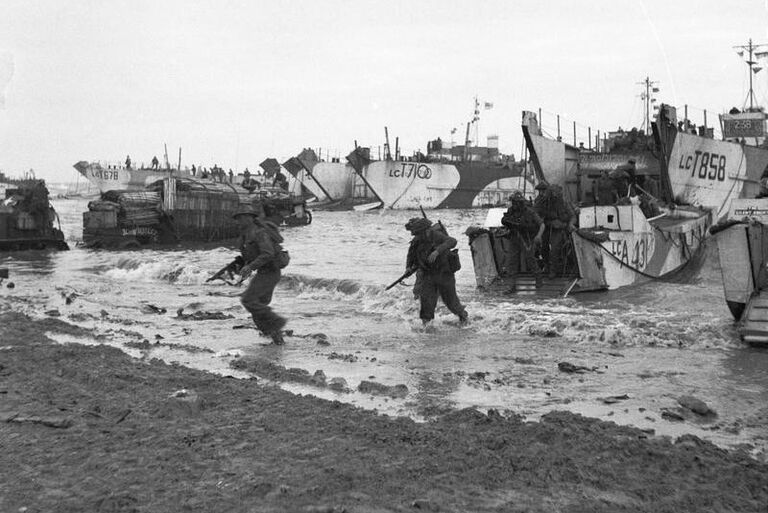
Landing at Gold Beach
Buying Smokes
You can see that these British soldiers weren’t part of the fighting because they still had well-shined boots. They were headed to D-Day, stopping in an English town to get some cigarettes. This photo was taken on May 28.
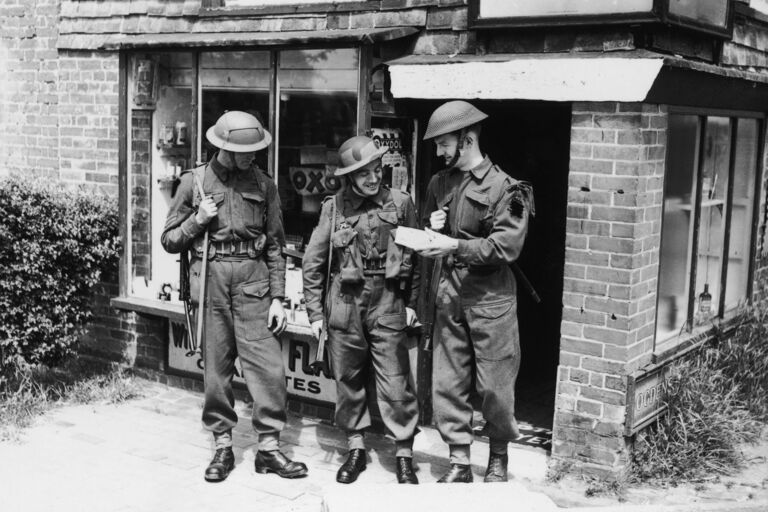
Buying Smokes
Destruction
The soldiers here were checking the remains of the German gun and bunker site. It was part of the defensive system set up at Gold Beach. Though the British infantrymen demolished it all, they needed three tanks to get the job done.
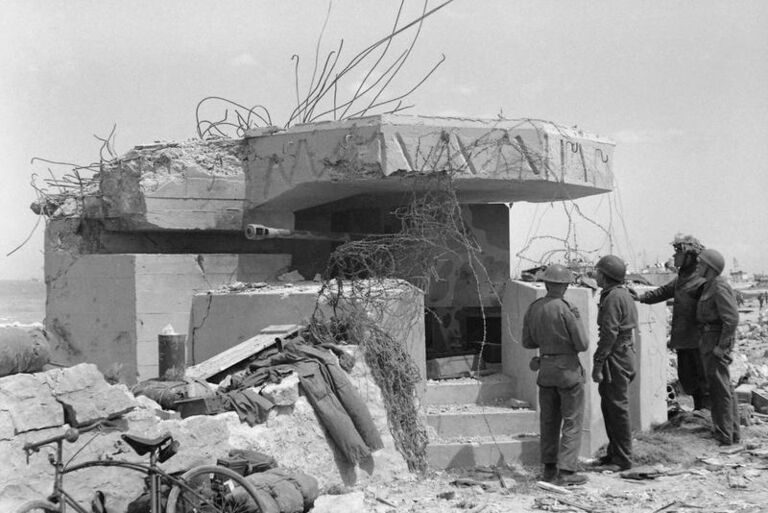
Destruction


